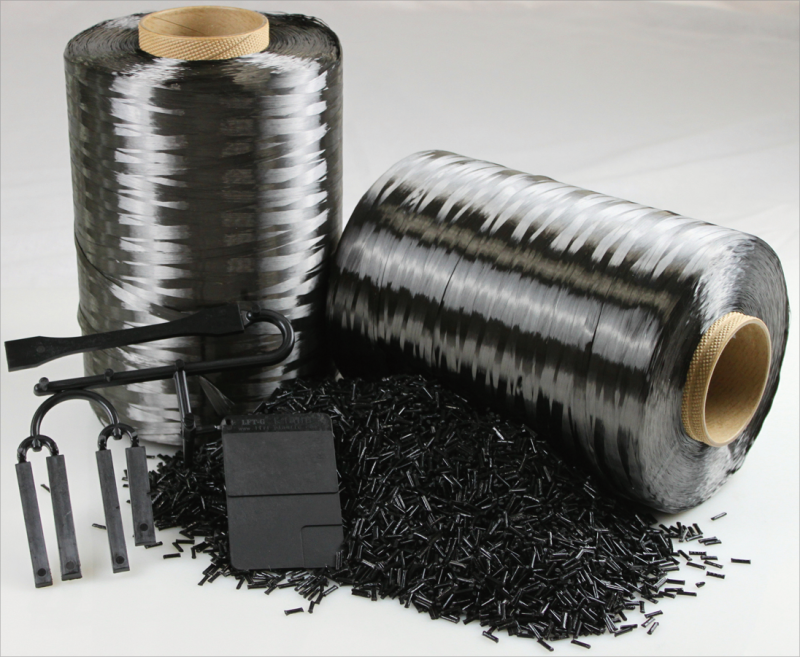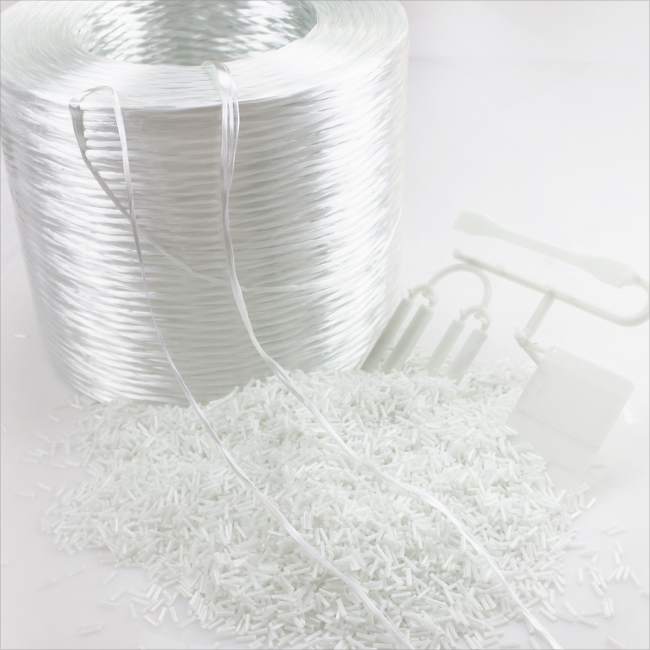
1. 인장강도
인장강도는 재료가 늘어나기 전에 견딜 수 있는 최대 응력을 말합니다. 일부 비취성 재료는 파손되기 전에 변형되지만, Kevlar® 섬유, 탄소 섬유 및 유리 섬유는 취성이며 거의 변형 없이 파손됩니다. 인장강도는 단위 면적당 힘(Pa 또는 Pascal)으로 측정됩니다.
응력은 힘이고, 변형은 응력으로 인한 휘어짐입니다. 다음은 일반적으로 사용되는 세 가지 강화 섬유인 탄소 섬유, 아라미드 섬유, 유리 섬유 및 에폭시 수지의 인장 강도 비교를 보여줍니다. 이 수치는 비교용일 뿐이며 제조 공정, 아라미드 조성, 탄소 섬유의 전구체 섬유 등에 따라 MPa 단위로 달라질 수 있다는 점에 유의하는 것이 중요합니다.
탄소섬유 : 4127
유리섬유: 3450
아라미드 섬유: 2757
2. 밀도 및 중량 대비 강도 비율
세 가지 재료의 밀도를 비교하면 세 가지 섬유 사이에 상당한 차이가 있음을 알 수 있습니다. 정확히 동일한 크기와 무게의 샘플 3개를 만들면 Kevlar® 섬유가 훨씬 더 가볍고, 탄소 섬유가 그 다음이고, 유리 섬유가 가장 무겁다는 것이 곧 명백해집니다.
따라서 동일한 중량의 복합재료에 대해 탄소섬유나 Kevlar®가 더 높은 강도를 얻을 수 있다. 즉, 주어진 강도를 요구하는 탄소섬유나 Kevlar® 복합재로 만든 구조물은 유리섬유로 만든 구조물보다 작거나 얇습니다.
샘플을 제작하고 테스트한 결과, 유리섬유 복합재의 무게는 Kevlar®나 탄소섬유 적층판보다 거의 두 배나 나가는 것으로 나타났습니다. 이는 Kevlar® 또는 탄소 섬유를 사용하면 무게를 많이 줄일 수 있음을 의미합니다. 이 특성을 강도 대 중량비라고 합니다.
3. 영률
영률은 탄성 재료의 강성을 나타내는 척도이며 재료를 설명하는 방법입니다. 이는 단축 변형(동일 방향 변형)에 대한 단축(한 방향) 응력의 비율로 정의됩니다. 영률 = 응력/변형률. 이는 영률이 높은 재료가 영률이 낮은 재료보다 단단하다는 것을 의미합니다.
탄소섬유, Kevlar®, 유리섬유의 강성은 매우 다양합니다. 탄소섬유의 강성은 아라미드 섬유의 약 2배, 유리섬유의 강성은 5배이다. 탄소 섬유의 뛰어난 강성의 단점은 부서지기 쉬운 경향이 있다는 것입니다. 실패하더라도 큰 변형이나 변형을 나타내지 않는 경향이 있습니다.
4. 가연성 및 열분해
Kevlar®와 탄소 섬유는 모두 고온에 강하고 융점이 없습니다. 두 재료 모두 보호복과 내화성 직물에 사용되었습니다. 유리 섬유는 결국 녹게 되지만 고온에도 매우 강합니다. 물론 건물에 사용되는 반투명 유리섬유는 내화성을 향상시킬 수도 있습니다.
탄소 섬유와 Kevlar®는 보호용 소방용 담요나 용접용 담요 또는 의류를 만드는 데 사용됩니다. Kevlar 장갑은 육류 산업에서 칼을 사용할 때 손을 보호하기 위해 일반적으로 사용됩니다. 섬유는 단독으로 사용되는 경우가 드물기 때문에 기재(보통 에폭시)의 내열성도 중요합니다. 에폭시 수지는 열에 노출되면 빠르게 부드러워집니다.
5. 전기전도도
탄소 섬유는 전기를 전도할 수 있지만 Kevlar®와 유리 섬유는 그렇지 않습니다. Kevlar®는 송전탑에서 케이블을 당기는 데 사용됩니다. 전기를 전도하지는 않지만 물을 흡수할 수 있으며 물은 실제로 전기를 전도할 수 있습니다. 따라서 이러한 응용 분야에서는 Kevlar에 방수 코팅을 적용해야 합니다.
탄소섬유는 전기 전도성이 있기 때문에 다른 금속 부품과 접촉하면 갈바닉 부식이 문제가 됩니다.
6. 자외선 저하
아라미드 섬유는 햇빛과 높은 UV 환경에서 품질이 저하됩니다. 탄소섬유나 유리섬유는 자외선에 그다지 민감하지 않습니다. 그러나 에폭시 수지와 같이 일반적으로 사용되는 일부 기재는 햇빛에 남아 하얗게 변하고 강도를 잃습니다. 폴리에스테르 및 비닐 에스테르 수지는 자외선에 대한 저항력이 높지만 에폭시 수지보다 저항력이 떨어집니다.
7. 피로회복
부품을 구부리고 펴는 일을 반복하다 보면 피로로 인해 결국 파손될 수 있습니다. 피로에 다소 민감하고 심각한 손상을 입는 경향이 있는 탄소 섬유에 비해 Kevlar®는 피로에 더 강합니다. 유리섬유는 그 사이 어딘가에 있습니다.
8. 내마모성
Kevlar®는 내마모성이 강하여 절단이 어렵습니다. Kevlar®의 일반적인 용도 중 하나는 유리나 날카로운 칼날에 손이 베이는 부위에서 사용하기 위한 보호 장갑입니다. 탄소섬유와 유리섬유는 저항력이 약합니다.
9. 내화학성
아라미드 섬유는 강산, 강염기 및 섬유 분해를 일으킬 수 있는 특정 산화제(예: 차아염소산나트륨)에 민감합니다. 일반 염소 표백제(예: Clorox®) 및 과산화수소는 Kevlar®와 함께 사용할 수 없으며, 산소 표백제(예: 과붕산나트륨)는 아라미스트 섬유를 손상시키지 않고 사용할 수 있습니다.
탄소섬유는 매우 안정적이며 화학적 분해에 민감하지 않습니다.
10. 매트릭스 결합 성능
탄소 섬유, Kevlar® 및 유리가 최상의 성능을 발휘하려면 매트릭스(일반적으로 수지) 내에 제자리에 유지되어야 합니다. 따라서 수지가 다양한 섬유와 결합하는 능력이 중요하다.
탄소섬유와 유리섬유는 수지에 쉽게 달라붙을 수 있지만, 아라미돈 섬유와 수지를 합하면 강도가 원하는 만큼 강하지 않고, 이로 인해 접착력이 떨어지면 수분 침투가 발생하게 됩니다. 결과적으로 아라미드 섬유는 물을 흡수하는 경향이 있으며, 이는 에폭시 수지에 대한 불만족스러운 접착력과 결합되어 kevlar® 복합재의 표면이 손상되어 물이 들어갈 수 있는 경우 Kevlar®가 섬유를 따라 물을 흡수하여 약화될 수 있음을 의미합니다. 복합.
11. 색상 및 직조
아라미드의 자연 상태는 연한 금색이며 다채로울 수 있으며 현재는 좋은 색상이 많이 있습니다. 유리섬유는 컬러로도 제공됩니다. 탄소섬유는 항상 검은색을 띠며 유색 아라미드와 혼합될 수 있으나 단독으로 착색될 수는 없다.

(탄소섬유)

(유리섬유)